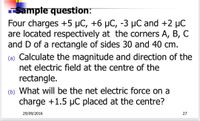Question
thumb_up100%

Transcribed Image Text:Sampte question:
Four charges +5 µC, +6 µC, -3 µC and +2 µC
are located respectively at the corners A, B, C
and D of a rectangle of sides 30 and 40 cm.
(a) Calculate the magnitude and direction of the
net electric field at the centre of the
rectangle.
(b) What will be the net electric force on a
charge +1.5 µC placed at the centre?
29/09/2016
27
Expert Solution
This question has been solved!
Explore an expertly crafted, step-by-step solution for a thorough understanding of key concepts.
Step by stepSolved in 5 steps with 1 images

Knowledge Booster
Similar questions
- The cockroach Periplaneta americana can detect a static electric field of magnitude 6.00 kN/C using their long antennae. If the excess static charge on a cockroach is modeled as point charges located at the end of each antenna, what magnitude of charge q would each antenna possess in order for each antennae to experience a force of magnitude 5.50 µN from the external electric field? Calculate q in units of nanocoulombs (nC). q= nCarrow_forwardThe figure below shows a small, charged bead, with a charge of q = +41.0 nC, that moves a distance of d = 0.174 m from point A to point B in the presence of a uniform electric field E of magnitude 255 N/C, pointing right. A positive point charge q is initially at point A, then moves a distance d to the right to point B. Electric field vector E points to the right. (a) What is the magnitude (in N) and direction of the electric force on the bead? magnitude Ndirection (b) What is the work (in J) done on the bead by the electric force as it moves from A to B? J (c) What is the change of the electric potential energy (in J) as the bead moves from A to B? (The system consists of the bead and all its surroundings.) PEB − PEA = J (d) What is the potential difference (in V) between A and B? VB − VA = Varrow_forwardTwo charges are located in the x-y plane. If q1 -3.50 nC and is located at (x = 0.00 m, y = 0.960 m), and the second charge has magnitude of q2 = 4.80 nC and is located at (x = 1.40 m, y 0.650 m), calculate the x and y components, Ex and Ey, of the electric field, É, in component form at the origin, (0, 0). The Coulomb force constant is 1/ (4reo) = 8.99 x 10° N · m²/C². -13.58 -40.45 Ex N/C Ey N/C Incorrect Incorrect IIarrow_forward
- Four identical charged particles (g = +10.1 µC) are located on the corners of a rectangle as shown in the figure below. The dimensions of the rectangle are L = 64.2 cm and W = 14.6 cm. L (a) Calculate the magnitude of the total electric force exerted on the charge at the lower left corner by the other three charges. (b) Calculate the direction of the total electric force exerted on the charge at the lower left corner by the other three charges. ° (counterclockwise from the +x-axis)arrow_forwardFour identical charged particles (q +10.4 pC) are located on the corners of a rectangle as shown in the figure below. The dimensions of the rectangle are L 54.6 cm and W 14.7 cm L W (a) Calculate the magnitude of the total electric force exerted on the charge at the lower left corner by the other three charges. N (b) Calculate the direction of the total electric force exerted on the charge at the lower left corner by the other three charges. (counterclockwise from the x-axis)arrow_forwardThere are two point charges q1=(1.000x10^1) µC and q2=(-4.00x10^0) µC. q1 is located at origin (0, 0). q2 is located at ((2.000x10^0) m,(4.0000x10^0) m). Please calculated the x-component of the electrostatic force on q2 . Give your answer in the unit of N with 3 sf.arrow_forward
- The cockroach Periplaneta americana can detect a static electric field of magnitude 9.00 kN/C using their long antennae. If the excess static charge on a cockroach is modeled as point charges located at the end of each antenna, what magnitude of charge q would each antenna possess in order for each antennae to experience a force of magnitude 4.50 µN from the external electric field? Calculate q in units of nanocoulombs (nC). q = nCarrow_forwardThe figure below shows a small, charged bead, with a charge of q = +42.0 nC, that moves a distance of d = 0.189 m from point A to point B in the presence of a uniform electric field E of magnitude 270 N/C, pointing right. A positive point charge q is initially at point A, then moves a distance d to the right to point B. Electric field vector E points to the right. (a) What is the magnitude (in N) and direction of the electric force on the bead? magnitude Ndirection (b) What is the work (in J) done on the bead by the electric force as it moves from A to B? J (c) What is the change of the electric potential energy (in J) as the bead moves from A to B? (The system consists of the bead and all its surroundings.) PEB − PEA = J (d) What is the potential difference (in V) between A and B? VB − VA = Varrow_forward
arrow_back_ios
arrow_forward_ios